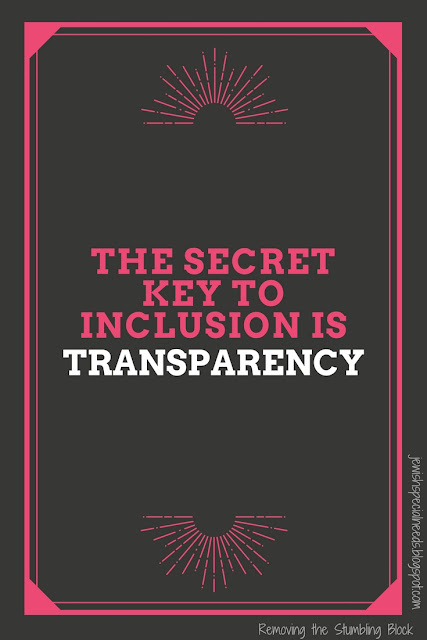This post may contain affiliate links.
What are you doing to ensure your community is as inclusive as it can be?
All too often communities feel that they can’t use the language of inclusion if they aren’t “inclusive enough” (let’s not talk now about those who call themselves inclusive but really aren’t…that’s another challenge for another day).
Here is a piece that I think is significant: Even if you cannot make every single change
that you hope to make at once, being transparent about your efforts and helping
your community know that inclusion is something you value will go a tremendous
way.
It is ABSOLUTELY acceptable to say that you are making
efforts to be as inclusive as possible as you work to make the necessary changes
and shape the culture of your community. The
key here is transparency.
 By sharing what you are up to you open the conversation. You
help others know that inclusion is something your community values. This may
lead others to be willing to share their own needs more readily or even step up
to the task helping. When you make inclusion a part of the conversation, you can
begin to shift the focus from what you are not doing to what you haven’t done yet. And
yet is powerful.
By sharing what you are up to you open the conversation. You
help others know that inclusion is something your community values. This may
lead others to be willing to share their own needs more readily or even step up
to the task helping. When you make inclusion a part of the conversation, you can
begin to shift the focus from what you are not doing to what you haven’t done yet. And
yet is powerful.
All the while you can feel proud of the steps you take
and the shifts you make.
For those who are wondering, inclusion does not have
to look the same in every place or every space. For those who need some
concrete examples of what inclusion looks like, here are a few from my community.
This is inclusion:
- When you rearrange the entire school’s music schedule (from what it has been in previous years) to accommodate one student - and the teachers all think it's a great idea…this is inclusion.
- When a teacher comes to the opening faculty meeting excited about her plan to communicate regularly with the parent of a student in high school with significant need so that he can participate successfully…this is inclusion.
- When, at the opening faculty meeting, a teacher asks if fidgets will be back in the classrooms before we even get to the place on the agenda to review fidget guidelines…this is inclusion.
- The check-ins and conversations with individual parents of children with significant needs in advance of the opening of school to make sure everyone is on the same page for opening day…this is inclusion.
Will you need to make some costly changes to be inclusive? Maybe.
Will you need to put in significant effort to be inclusive?
Probably.
Will it take time to get everyone on board and shift the
culture of your community completely? Likely.
But none of these are
reasons that you shouldn’t start.
Start small. Do a lot of listening. And share what you are up to every step of the way.
Be sure you
never miss a post from Removing the Stumbling Block:

No comments:
Post a Comment